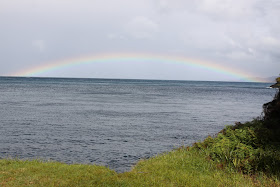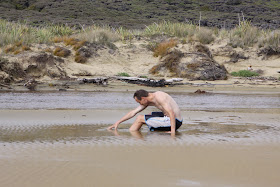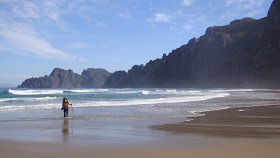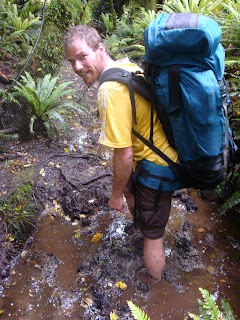
An old bush telephone on the outskirts of Oban, the only town on Stewart Island.
Once we arrived at Oban in Halfmoon Bay, we headed over to the DOC office to obtain permits. Before getting them, we had to be assured that we could expect hip high mud and lots of misery. They even showed us a quotes page about one section of track that some people thought should be closed. The DOC recommended not hiking that section and taking the ferry around it. I reckon they were in cahoots with the ferry operators. A little extra money on the island would certainly not hurt things.

A small cottage overlooking Horseshoe Bay. I liked how the bed and dining room faced the water.
After getting our paperwork, we were off. Unlike most of the walks I've done in NZ that require a long car ride, this walk is accessible from town. They even include the 7km road section as part of total track length. I was tempted to hitch, but I know I'm a little too proud for that. As we walked down the road, we were passed by our fellow ferry passengers driving out and back to the giant chain at the trailhead.

A chain to keep Stewart Island conncted to the South Island of NZ.
The first thing I did when we got to the trailhead is break my spare water bottle. The first thing mother nature did was start to rain. At least the road portion was dry. The first part of our track was shared with the Rakiura Great Walk and well maintained. We stayed relatively dry under the trees as we moved quickly to the empty Port William Hut and had lunch.
The infamous Stewart Island mud.
After lunch, we broke off from the Great Walk trail to the Northwest circuit trail which is not a maintained track. If anything, I think they make the start of it worse so that anyone who isn't prepared will turn back. Within one hundred meters of branching off, we hit out first mud. It wasn't too bad. However, the next puddle dwarfed the first one. The third was the same size, but wetter. Each subsequent puddle of mud seemed to put the last one to shame. It was laughably ridiculous. We were trying to be pansies and use roots to go over it or just walk around it. Somewhere in the first couple hours of mud, my Keens broke.

Shoe repair number one.
I felt pretty sure my Keens would not survive the hike, but I didn't think they would go on day one. The heel strap on both shoes snapped so I was basically wearing clogs and clogs weren't going to get the job done. Luckily, I had not taken out the extra shoe laces I keep around for MacGyvering. I wrapped the shoe laces around my ankles and the shoe tongue four times and used the old heel strap to prevent chafing. Surprisingly, it worked pretty well.

The beach at our first hut. Smoke coming out of the hut was a boon.
When we finally rolled into Bungaree Hut, we were greeted by the welcome sight of smoke coming out of the chimney. Someone else was already there. Fire to warm up and dry our clothes was good. Visitors are only good sometimes. I'm sensitive about who I spend my time camping with because I usually go into the woods to get away. Anyway, these particular visitors were a lot drier than us. They had come in via ferry and helicopter with a little walking.

Hannan walks ahead in the lush forest.

Hannan strikes a pose on Murray Beach. His smile disappeared when the sandflies appeared.

Brilliant lighting beneath the clouds.

A respite from the rain, but not from the sandflies. I just wanted a break. They just wanted a lunch break . . . on me.

Horizontal fungus.
Stewart Island mud on a sunny day.

Rest stop.
Our second day brought us to the Christmas Village Hut where we were joined by another couple who had taken a helicopter in because the last time they did it they remember the first two days being unpleasant. They were right. The second day was the same as the first, but with a little more rain, random sunshine and blue patches (or blue clouds as Hannan liked to call them), and sandfly storms. It seemed to only be sunny when we were in the woods. The one time it was sunny on the beach, the sandflies had a lot to say about us passing through their territory without paying a toll. The DOC suggested using that hut as a turn back point if things were going wrong. My keens held together alright with a few adjustments and reties. The couple at the hut told us that the people who do turn back have a lot of negative things to say about the Northwest Circuit because they spend four days instead of two going through what seems to be the worst mud. I think the trick to enjoying it (with so many things in life) is it to surrender to your conditions. Stop fighting what you can't control. Once we did that, we just walked right through the mud instead of around it and laughed a lot more.

A rainbow at Christmas Village Hut after one of the many rains.
Our third day was just like the second. We stopped in at the Yankee River Hut, but chose to move on because we were going to have to skip a hut sooner or later and it was also full of hunters. It was a very long day. However, as we descended to Long Harry Hut at the end of our third day, we caught this amazing view of our hut overlooking the crashing sea below. It was an oasis in the rain. If I wasn't so tired and wet, I probably would have sat there soaking in the view. That amazing hut turned out to not be quite as amazing as I'd like because it was also filled with hunters. They had taken over the place and had their stuff everywhere. Also, to get to the hut you had to walk down to the beach below and then back up. We were tired and really didn't want to have go down just to go back up to get to the hut. The view was amazing. It was warm. It was a place to sleep. The sandflies were ridiculous. The first three days of this hike were good, but I didn't think they were worth the long journey and the hype even in good weather. However, things were about to get better.

Descending down to Long Harry Hut.

My keens after their first break. My socks also didn't make it.
The next morning we set off early. Hannan was moving slow and the sandflies were ferocious so I told him to catch up with me on the trail since my Keens were slowing me down a bit and he is a faster hiker anyway. I didn't want to be a free meal for anymore sandflies. I got more bites that morning than any other and it might have been worth it. If I didn't get those bites, I wouldn't have left early, heard a rustle in the woods, and turned to see this endangered fellow sniffing around.

My first kiwi!!
Stewart Island has a special type of kiwi that comes out during the day as well as at night. They are usually quite shy. They have a keen sense of smell, but are mostly blind and deaf. As long as we didn't walk on the ground too heavily or rustle any plant leaves, it did not react to us. It even walked right up to us to smell us. I thought it was going to go searching in my Keens for a minute. They are much bigger than I imagined from the pictures I'd seen in the past. They are a treat to observe. I think they are neatest when they go to war with an underground worm to eat it. Happening upon this kiwi made the previous three days of wet, rain, and mud worth it. I hope the short video can let you enjoy them as much as I did.
Video of our first kiwi sighting.

A kiwi, the kind that isn't a fruit and doesn't talk with an accent!!!
After the kiwi left us, the rain let up and the sun came out. We had to cross one rocky beach that took me straight back to my childhood. The mile of giant boulders were reminiscent of the rocks on the way to Saturday Cove, ME from our house. I took off my Keens and enjoyed it just as I had enjoyed it as a little kid, minus the 40 lb. pack.

Sometimes the track was a little steep.

It was heavenly to be walking on the giant boulders in bare feet that reminded me of going to the Cove as a kid.

A spectacular view of East Ruggedy beach where we would be spending the night.

Quick sand, I kid you not. It does exist!
After a few days of smelling ourselves, we decided a wash in the ocean at East Ruggedy beach and a rinse in the river were overdue. Near where the river met the ocean, Hannan suddenly fell into the sand past his knees. He had found a patch of quick sand. Quick sand is a hydrogel of fine granular matter (such as sand or silt), clay, and salt water. Hannan couldn't get himself out at first. Luckily, I watched Indiana Jones enough to know that I needed to get my whip and just wrap it around him and the nearest tree. Without a whip or a tree, I let him figure it out for himself. It was amazing because we thought we were on solid sand. On closer inspection, the sand was reacting to us like water to water bugs. The liquid-sand mixture had strong enough attractive bonds to not let us break through though. Hannan must have found a place where the bonds were weak or just pushed a toe through. I regret not getting a video of it.

Hannan gets dinner at the East Ruggedy hut.

Sunset on the dunes at East Ruggedy

Sunset at East Ruggedy beach (go to West Ruggedy for sunset next time)

Gourmet camp cooking.

Grilled cheese in the bush!
Our night at East Ruggedy Hut was my favorite. There were only five of us so it was nice and quiet. We caught sunset over the sand dunes. We saw a ton of stars. I almost stepped on a kiwi in the night. Hannan cut meat off a day old, fly covered deer that a hunter left hanging from a tree for anyone to eat. Hannan says it should be good for up to nine days. Ick (not as a vegetarian, but about the flies and possible time on the tree). I made a grilled avocado and cheese sandwich. To me, that is a luxury item. I don't know if its more ridiculous that I had it or that I carried an avocado for five days so I could have it. That sandwich motivated me through a couple days. Good, good stuff.

A dead pilot whale.
Leaving the goodness of East Ruggedy beach, we headed over to West Ruggedy beach (which would probably be much better for sunset). West ruggedy beach had 19 dead beached pilot whales, one which was fresh. Death is a part of life, but I haven't been able to embrace it the same way. I was sad to see the whales beached. Scientists don't know why they do it. Man made causes (sonar) have been blamed. We effect a lot of things on Earth in ways we don't realize until it is too late.
More Stewart Island mud.

The beach was a welcome relief from the mud . . . until the sand flies would show up (photo by Hannan).

An arch on the beach. I love how the lower side of the clouds are being pulled away.

Hannan is about to be swallowed whole by the hundreds of sandflies around him.

More great beaches and mountains.
Our hike to Hellfire on our fifth day proved to be one of the most challenging for me. It was a long day in deep mud. Near the end, both my Keens gave up. The two straps closest to the heel which kept the sole near my heel both came apart within a mile of each other. This meant I was basically wearing toe clogs. The heel straps that I had rigged up only kept the shoe from moving front and back. It was like wearing flip flops, but without the ability to grip the shoes with your toes. It sucked, especially with slippery mud. I wasn't happy. At the hut, I cut two holes in each sole near the heel and ran the shoe strings through there. This gave me two vertical back straps that I could rig a horizontal strap on to. It was brilliant or terrible. Those shoes just wanted to be done and I kept prodding them onward.
One of the strangest things about this hike was that we found sand dunes at 750m above sea level in the middle of the woods with no apparent reason why they should be there. It reminded me of how odd it was to visit the sand dunes in Colorado. These weren't very large, but they were two minutes from the hut so they were perfect for going to watch sunset and ponder just how they got there. I got cold. I finished off my gummies. I didn't come up with an answer.

Sunset from the sand dunes near Hellfire Hut.

Little Hellfire Beach.

Huge pieces of kelp just off Little Hellfire Beach

Washing the mud off my shoes and feet (photo by Hannan)
The day hike from Big Hellefire Hut to Mason Bay Hut was one we were looking forward to. Mason Bay and its hut were rumored to be the best parts of the hike. After the usual ups and downs, we were dumped out on the Mason Bay beach for two hours of beach walking. It was drizzling. The sandflies weren't able to keep up with us and my Keens were holding up. Unfortunately, it was the day my Achilles started hurting too. Almost a month later, it is still hurting.
When we arrived at Mason Bay Hut, it was a bit of a bummer. Our idea of a quiet hut with great kiwi viewing away from everything was not accurate. A number of people had taken a sea plane in. Others had ferried near by and walked 3 hours on a old road. Only one guy had walked the full trail in. A few were there to do the Northwest circuit. A few were there to do the shorter and muddier Southern Circuit. Most were there for a night to see kiwis before heading back to town. If I didn't have time, I'd do the same thing. After hiking for six day, finding that large of an increase in the hut population was just a bit jarring.

Manuka trees beside an irrigation canal.

Daniel and Hannan

A Tomtit.
Our last kiwi

The swing bridge over to Freshwate Hut.
After a great night of rest at Mason Bay, we set off for the Freshwater Hut. It was a completely flat walk beside an irrigation canal. We saw our last kiwi on the way. Once we got to the hut, we grabbed lunch and discussed whether or not to stay the night, take the ferry, or walk Thompsons Ridge which we had been warned against. The night before a guy had said he hiked the ridge and it was doable. We decided that since it had not done anything more than drizzle in three days, we should double up, skip staying the night in Freshwater Hut, and cross the ridge when it was dry out instead of risking a rain coming down while we slept. It turned out not to be a big deal. I think the warnings came from overnighters or inexperienced, not Northwest Circuit, trampers. It wasn't anything worse that we had seen on other days. My only struggle came from overtaxing my Achilles. My latest Keen fix was still working great. It was even working better than when I started the hike!
Still more mud on the tramp.

The Paterson Inlet.
The last day was uneventful except the amount of boardwalk we walked on. The Great Walks are the most cared for tramps in New Zealand. If you weren't walking on the boardwalk though, you'd probably be trudging through mud. Who is to say which is better. If it is really muddy, less people may come to visit or they'll just take the ferry around to the parts they want to see. I was just happy to be getting to the end of the hike. Too many nights of bad sleep and a lot of exerting the body had exhausted me.

I've thought it many times before, but I'm going to use this as proof that NZ was the inspiration for the movie Fern Gully.

The DOC lists Darwin's barberry as a weed to be reported immediately. We found it odd that this one was on the road to the trail.

A new twist on trespassing signs.

A single tuk-tuk taxi on Stewart Island with some cheeky marketing.
If I had to sum up the Stewart Island trip, I'd talk about plants, kiwis, hiking with a Kiwi nationalist, beaches, rain, mud, sandflies, a single night of stars, the end of my Keens, people, sunshine, and not enough sleep. I'm not sure if I'd recommend it to people. I wanted to see kiwis. I wanted to see beauty. I got both. I think if someone just wanted beauty, there are other similar hikes that give just as much for less work. For kiwis though, it can't be beat. Those little guys are a treat.

Stuck in the mud (photo by Hannan).
The Northwest Circuit (125km) by the numbers (map):
Day 1 (18km):
- Halfmoon Bay to Port William Hut, 12 km
- Port William Hut to Bungaree Hut, 6 km
- Bungaree Hut to Christmas Village Hut, 11.5 km
- Christmas Village Hut to Yankee River Hut, 12 km
- Yankee River Hut to Long Harry Hut, 8.5 km
- Long Harry Hut to East Ruggedy Hut, 9.5 km
- East Ruggedy Hut to Big Hellfire Hut, 14 km
- Big Hellfire Hut to Mason Bay Hut, 15 km
- Mason Bay Hut to Freshwater Landing Hut, 15.5 km
- Freshwater Landing Hut to North Arm Hut, 11 km
- North Arm Hut to Halfmoon Bay, 12 km

My retired and replacement Keens.
The videos are sideways because Hannan rotated the camera to film them. I couldn't find a way to easily rotate video, so I didn't. Sorry about that.
ReplyDeleteNice post! Thanks for writing it up. As for the tracks, at least the boardwalks keep people from trying to avoid the mud and go around, causing more erosion in a larger area than just on the track. But you're right. It's a loose-loose for the environment.
ReplyDeletemiss you!
Maybe you should have your red keens bronzed. You could create a little shrine to them. Displaying where they took you throughout your travels and pics of you wearing them in different locations.
ReplyDeleteThe videos are great. It's a nice addition to the amazing photos.
Thanks for the great write up on the Northwest Circuit it was on of my most favourite experiences. We did it in fishing waders which dealt to the mud quite well.
ReplyDeleteHi there, great blog! Loved your NW Circuit post! :) It just looks like you've got a nice photo of Stewart Island robin there, not a tomtit?
ReplyDeleteYou could be right about the robin. I was going off what someone else told me. Awfully curious fella!
ReplyDeleteThanks for reading!
Hi,
ReplyDeleteMy wife and I are settting of on the NW Circuit later this week - enjoyed your account. We are doing it "backwards" starting at Freshwater. Would be interested to know what time of the year you did the trip, late March? - esp, with respect to hunters in huts.\\Cheers, Euan Nicol.\\p.s. Robin!!
I'm glad the writing could help.
ReplyDeleteWe did this tip in late Feb/early March 2010.
-Brody
Hi Brody,
ReplyDeleteFirst of all, thanks for great and detailed post! Me and friends plan to go NW Circuit next week (middle of July) but we have only six days.
Could you reсall for how long you walked each day? Was it faster/slower than "official" estimates in DOC track description?
Also what is the rough percentage of the track covered with DEEP mud? We don't afraid to get wet and just will go through shallow mud like you suggested, we care about mud that significantly affects walking speed
125km/77 miles in 6 days....10-15 miles a day on the NW circuit is definitely doable. You'll either be getting up early or walking in the dark, but you can do it.
DeleteWe were faster than the estimates. I think only 5% of the track was covered in deep mud, but that varies from year to year.
You are in for a great time.
I hiked the NW circuit back in March 1993 and was looking for photos to show my kids to help explain what it was like. I was tramping solo at the age of 18. I remember being "adopted" by some hunters at one of the early huts - they fed me fresh venison stew! I remember taking a day off from backpacking to climb Mt. Anglem. I had some ankle troubles during the trip (heel pocket on one boot was sliding to the side), so I used that day to let it recover a little. I remember all the European trampers in the huts (especially a lot of Germans and Swiss). I never got to see Kiwis, but I remember hearing them in the night at the Mason Bay Hut. I paired up with somebody to do the hike from Mason Bay to Oban and we ended up pushing that in one very long day. The trail to Freshwater was underwater for a mile or more - the water was knee deep, and we had to be careful to stay on the underwater boards (I wonder why they didn't float) so we wouldn't sink in deeper. Great memories.
ReplyDelete